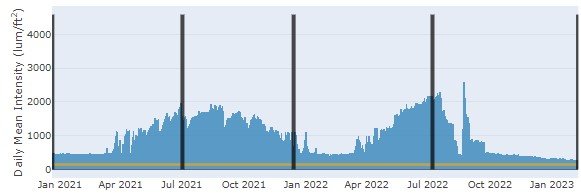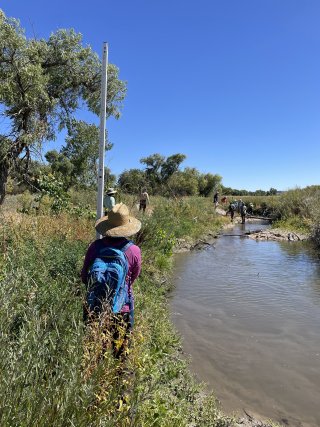Learn about Regional SDAMs
On this page:
Streams exhibit a diverse range of hydrologic regimes, and the hydrologic regime strongly influences the physical, chemical, and biological characteristics of active stream channels and their adjacent riparian areas. One important aspect of the hydrologic regime is streamflow duration—the length of time that a stream sustains flowing surface water. Determining streamflow duration class can help support a variety of regulatory and non-regulatory water resource management decisions. Various regulatory and scientific definitions have been given to the terms “perennial,” “intermittent,” and “ephemeral” streamflow; however the Environmental Protection Agency and the U.S. Army Corps of Engineers used the following definitions for the development of the Regional SDAMs.

Ephemeral reaches are channels that flow only in direct response to precipitation. Water typically flows only during and/or shortly after large precipitation events, the streambed is always above the water table, and stormwater runoff is the primary water source.
Intermittent reaches are channels that contain sustained flowing water for only part of the year, typically during the wet season, where the streambed may be below the water table and/or where the snowmelt from surrounding uplands provides sustained flow. The flow may vary greatly with stormwater runoff.
Perennial reaches are channels that contain flowing water continuously during a year of normal rainfall, often with the streambed located below the water table for most of the year. Groundwater typically supplies the baseflow for perennial reaches, but the baseflow may also be supplemented by stormwater runoff and/or snowmelt.
Graphs below are data from Stream Temperature Intermittency, and Conductivity (STIC) loggers deployed in channel thalweg (https://onlinelibrary.wiley.com/doi/10.1002/hyp.14809); blue areas represented as intensity is electrical conductivity signal and the yellow line represents the logger-specific calibration value for minimum presence of streamflow. The timing and duration of streamflow is represented where the intensity values (blue area) are above the calibration line. The black lines are site visits.



What are SDAMs?

SDAMs are rapid field assessment methods that use hydrological, geomorphological, and/or biological indicators, observable in a single site visit, with or without geospatial indicators to classify streamflow duration as perennial, intermittent, or ephemeral at the stream reach scale. A reach is a section of stream or river along which similar hydrologic conditions exist. For the SDAMs, streamflow duration is measured along a reach as one of three classes, ephemeral, intermittent, or perennial.
Streamflow duration indicators are rapid, cost-effective alternatives to direct hydrologic monitoring that still provide reach-specific classifications. Direct measurement of flow over time is resource intensive, often requiring years of data collection at the stream reach to identify a flow class. Regulators and water resource managers can instead use rapid, reach-scale methods to determine streamflow duration class (i.e., perennial, intermittent, ephemeral) and inform implementation of many federal, state, tribal, and local programs.
Regional SDAMs have proven to be highly accurate; the Arid West, Western Mountains, Great Plains and Pacific Northwest SDAMs correctly distinguished between ephemeral and intermittent/perennial streamflow with percentage accuracies in the 80s and 90s. Read more about the scientific basis for the SDAMs.
Because streamflow duration classes is unknown for most streams across the nation, the classifications from SDAMs can inform ecological assessments and resource management decisions, such as setting restoration goals or applying appropriate water quality standards. SDAMs also support identifying waters that may be subject to regulatory jurisdiction under the Clean Water Act or other authorities.
The SDAMs available on this website, known as Regional SDAMs, began with the development of an SDAM for the Pacific Northwest (PNW). The PNW SDAM has been in use since 2011 to inform state and federal regulatory decisions and other resource management decisions in the region. Following the same framework, EPA and the Corps have developed Regional SDAMs to cover the remaining coterminous United States which are also in use.
State and local SDAMs have been developed by state and federal agencies for a variety of purposes; examples include the North Carolina Method to implement riparian buffer regulations, the New Mexico Method to apply water quality standards, Tennessee Guidance for Hydrologic Determinations, the Fairfax County, Virginia Perennial Stream Field Identification Protocol. For more information about how other methods were considered in the development of the Regional SDAMs, see the Regional SDAM data supplement.
What Classifications can result from application of the Regional SDAMs?
Although the Regional SDAMs were designed to classify streams in one of three classes (i.e., perennial, intermittent, and ephemeral), three additional classifications are possible in cases when one of these classes cannot be assigned with a high level of confidence. The “less than perennial” classification occurs when an intermittent or ephemeral classification cannot be made with high confidence, but a perennial classification can be ruled out. The “at least intermittent” classification occurs when an intermittent or perennial classification cannot be made with high confidence, but an ephemeral classification can be ruled out. Lastly, the “needs more information” classification occurs when no individual classification is supported more than another.
